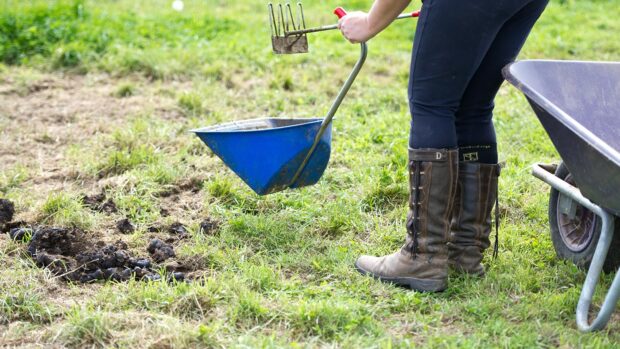Do your paddocks resemble the aftermath of a battle field? This step-by-step guide will have your paddocks back to health in no time…
Sample the soil
“Early spring is a good time to test your soil for any nutrient or mineral deficiencies that will limit future grass growth,” says Hazel Gwilym from Equine Paddock Maintenance. “A pH test can be carried out on site in the paddock or a sample can be collected and sent off to a lab.”
A soil sample will test for key nutrients including nitrogen, phosphorus and potassium. “Soils that are deficient in key nutrients will produce poor quality grass,” says Sophie Cookson, British Horse Society welfare co-ordinator. “The ideal pH level for horse pastures is between pH 6-6.5. If soil becomes too acidic lime will help to restore the ideal pH for grass growth.”
Mark Smith of Shire Country Services offers a soil sample test that will cost around £25+VAT. “That is for a basic agricultural soil sample which tells you the nitrogen, phosphorus and potassium levels,” he says.
Harrowing, seeding and rolling
“Springtime harrowing pulls up dead grass and thatch, aerates the sward and encourages better growth,” says Mark.
“Timing is crucial to both harrowing and rolling, if you are able to kick the soil surface and it not stick to your boots or it has a crumbly texture it gives a fair indication that your ground is suitable for work to commence,” adds Hazel.
Re-seeding can be performed from late March through to late September and should be followed by rolling to encourage germination and consolidate loose soil.
“When reseeding, we suggest anything from 5 kilos upwards per acre which costs around £4 per kilo,” Mark says. “The soil needs to be warm for the seed to germinate.”
Specialist seed mixes, which incorporate a mixed sward of grasses and herbs, are widely available for equine pasture to help provide the correct balance of nutrients.
“Horses should not graze young grass until it is well established,” Sophie advises. “New growth should ideally be five to six inches long before it is grazed and horses must be introduced to new pasture gradually.”
Traditionally, harrowing is used to spread the droppings on the pasture to act as a natural fertiliser.
“Pasture will be unpalatable to horses for a minimum of six weeks and internal parasites will be spread across the whole pasture,” explains Sophie. “Therefore, harrowing should be undertaken in dry, warm conditions, which allows the droppings to dry out and kill any parasites.”
Spraying and dealing with gateways
Weeds thrive on poached, damaged areas of pasture, particularly after a wet winter. “Weeds are stronger than grass and suppress grass growth,” says Mark.
“Spraying in the springtime should knock out 80-90% of the weeds. If you do that again the following year, you might end up with a clean soil and not need to spray for a few years. Speak to a specialist about the correct spray to use.”
Heavy traffic areas such as gateways and fence lines are typically bad after winter, so laying limestone, gravel, wood chip or grass matting will prevent further damage.
Like this? You might also enjoy reading these:
How to help prevent your horse from losing a shoe
The best way to deal with muddy gateways
Flooded paddocks — what’s the damage?
Elaine Jewkes, director of the British Grassland Society, offers some pointers on what may have happened and what to do.
“Poaching from hooves on wet ground causes small pockets of damaged grass, which allows weeds to get a hold. Weed seeds and debris may have also been brought in by floodwater, so keep an eye out over the season and address any problems promptly.
“It’s important to do a standard soil test, as although flooding may bring sediments rich in nutrients, it can also suffocate grass if the deposit is 5cm or more. Harrowing may help spread the sediments and allow the grass to grow.
“Lengthy flooding may have caused significant grass kill, so reseeding may be needed, depending on how bad the damage is.
“Floodwater can also cause physical and chemical changes in the soil that alter the structure, so when the soil is a little drier, dig some holes and assess the degree of compaction. If the damage is significant, slit aeration [method of aerating the soil] or sward lifting [lifting the topsoil just below the depth of compaction] may be needed — these are probably contractor jobs.”
Keep up to date with all the latest equestrian news, reports, interviews, features and much more in Horse & Hound magazine, on sale every Thursday.




